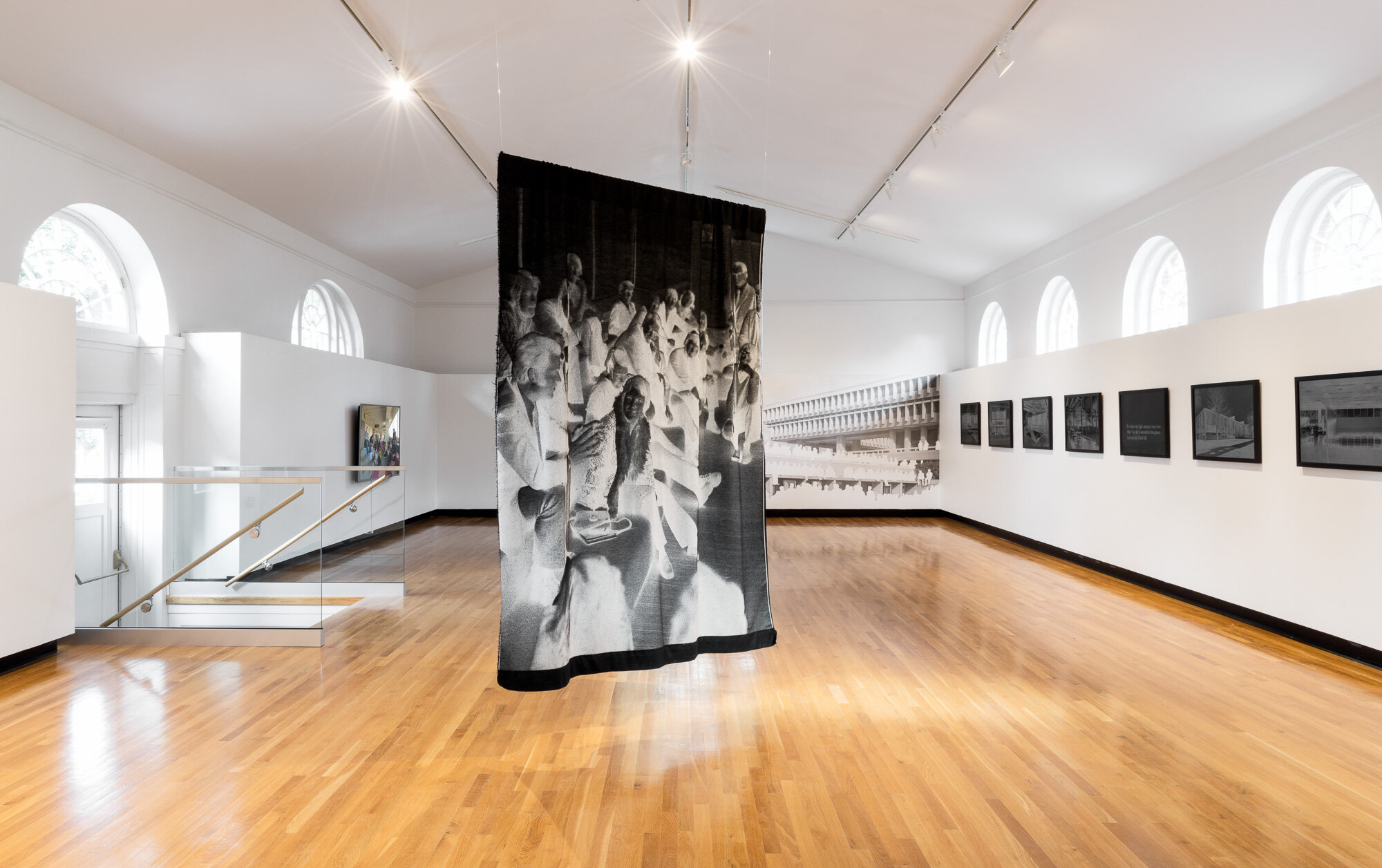Sabine Bitter and Helmut Weber, The Templeton Five Affair, March 1967, photographic mural. Courtesy of the artists.
PERFORMING EDUCATIONAL MODERNISM | SABINE BITTER & HELMUT WEBER
03.07.2021 to 12.09.2021
Opening Reception | July 3 | 8 PM
As the geographer Neil Smith has argued, a respatialization is a repoliticization; by calling the relationship of architecture and pedagogy into question and examining alternative spatializations, our project raises fundamental questions about knowledge production and knowledge mobilization, emerging from different perspectives of how place, land and space relate to our ways of learning and teaching.
— Sabine Bitter and Helmut Weber
Performing Educational Modernism centres on a period of post-war architecture and how the design of space influences learning. The 1960s and 1970s were a time when radical approaches in the design of learning spaces transformed the infrastructure of many institutions. Vancouver-based artist Sabine Bitter and Vienna-based artist Helmut Weber have undertaken extensive research into the relationships between pedagogical contexts and architectural spaces, their impact on learning experiences, and relationships between people. Through their artworks, Bitter & Weber analyze and critique this vernacular of architecture in relation to its intent: “The metaphor of the ivory tower gave way to that of the open university or free university. The newly built universities were meant to be the places where the masses could get access to education in order to acquire and produce the knowledge necessary to cope with processes of modernization, liberal democratization and new forms of economy based on skills and training.”
Bitter and Weber’s research-based creative practice examines the work of modernist architects, including Arthur Erickson (1924-2009), who conceived of a ‘whole-campus’ master plan for both Simon Fraser University and the University of Lethbridge. Erickson devised a methodology for rethinking the institution beyond its physical structures. He attempted to democratize the higher-learning facility through interdisciplinary common spaces for gathering and interaction. Erickson’s iconic, Brutalist structures connected social peripheries to educational centres. Cross-faculty learning spaces could facilitate access and progress in higher learning. The University of Lethbridge campus’ monolithic concrete structure is defined by an archetypal long concourse hallway with tiered landing spaces for public seminars. The artists utilize historical documentation, including photographs, interviews, and plan drawings, in their staged performances to interrogate how these architectural spaces function today. Bitter and Weber remark on returning to Erickson’s structures:
Half a century later, we revisit these architectural environments from the vantage point of artistic practice, investigating how these historical, arguably progressive spaces of learning may be reactivated today within the context of the neoliberalisation of educational institutions. In collaboration with architecture historians, archivists, teachers and students we explore the iconic sites, looking for traces and residual aspects of the former radical design. Deliberately, we focus on the architecture itself. The total campus design and its individual buildings present themselves to us an archive of social forces, materialized and brought into form.
Curated by Kristy Trinier
Sabine Bitter & Helmut Weber: Since 1993, Vancouver and Vienna based artists Sabine Bitter and Helmut Weber have worked on projects addressing cities, architecture, and the politics of representation and of space. Mainly working in the media of photography and video their research-oriented practice engages with specific moments and logics of the global-urban change as they take shape in neighborhoods, architecture, and everyday life. Since 2004, Sabine Bitter and Helmut Weber have been members of the cultural collective Urban Subjects, with Jeff Derksen.
Bitter & Weber’s recent projects and exhibitions include the following; 2021: Education Shock, HKW Berlin; Spaces of No Control, Austrian Cultural Forum, New York. 2019: Making Ruins, Republic Gallery, Vancouver; 2018: Camera Austria International, Museum der Moderne, Salzburg; Werkschau XXIII, Fotogalerie Wien, Vienna; Structures of Thought, Gallery Structura, Sofia; The Island is What the Sea Surrounds, Valetta, Malta. 2017: STRETCHING THE BOUNDARIES, FLUCA: Austrian Cultural Pavilion, Plovdiv, Bulgaria; Phantastischer Kapitalismus, Gallery GPLcontemporary, Vienna; As a text differs from a book, an image differs from an archive, Mackey Garage Top, MAK Center Los Angeles; The Vienna Model. Housing for the 21st Century City, Museum of Vancouver; Here & Elsewhere – Nothing to be done, Sarajevo. 2016: What is left?, frei_raum Q21, MuseumsQuartier Vienna. 2015: New Conjunctions and Intersections, United Nations Headquarters, New York; Through a Window: Visual Art and SFU 1965-2015, Teck Gallery, Vancouver; Informal Paths, MAXXI National Museum of XXI Century Arts, Rome. 2014: Punctum, Kunstverein Salzburg, Salzburg, Austria; Archives, Re-Assemblances and Surveys, Klovicevi dvori Gallery, Zagreb, Croatia. 2013: Tensta Museum: Reports from New Sweden, Tensta Konsthall, Stockholm, Sweden; Front, Field, Line, Plane – Researching the Militant Image, Kunstraum der Leuphana Universität Lüneburg; Self Made Urbanism Rome, NGBK Berlin; The Vienna Model, Austrian Cultural Forum New York. 2012: TIME, PLACE, AND THE CAMERA: PHOTOGRAPHS AT WORK | Gjon Mili, Kosova Art Gallery, Prishtina, Kosovo; Our Haus, Austrian Cultural Forum New York; Autogestion, or Henri Lefebvre in New Belgrade, The Power Plant Contemporary Art Gallery, Toronto; Global Prayers, Haus der Kulturen der Welt, Berlin; Envisioning Buildings, MAK, Vienna; The Urban Cultures of Global Prayers, Camera Austria, Graz; NGBK, Berlin. 2011: We: Vancouver, Vancouver Art Gallery; Communitas, The Unrepresentable Community, Camera Austria, Graz.
This exhibition was made possible with funding assistance from the Canada Council for the Arts, Alberta Foundation for the Arts, and the City of Lethbridge.











